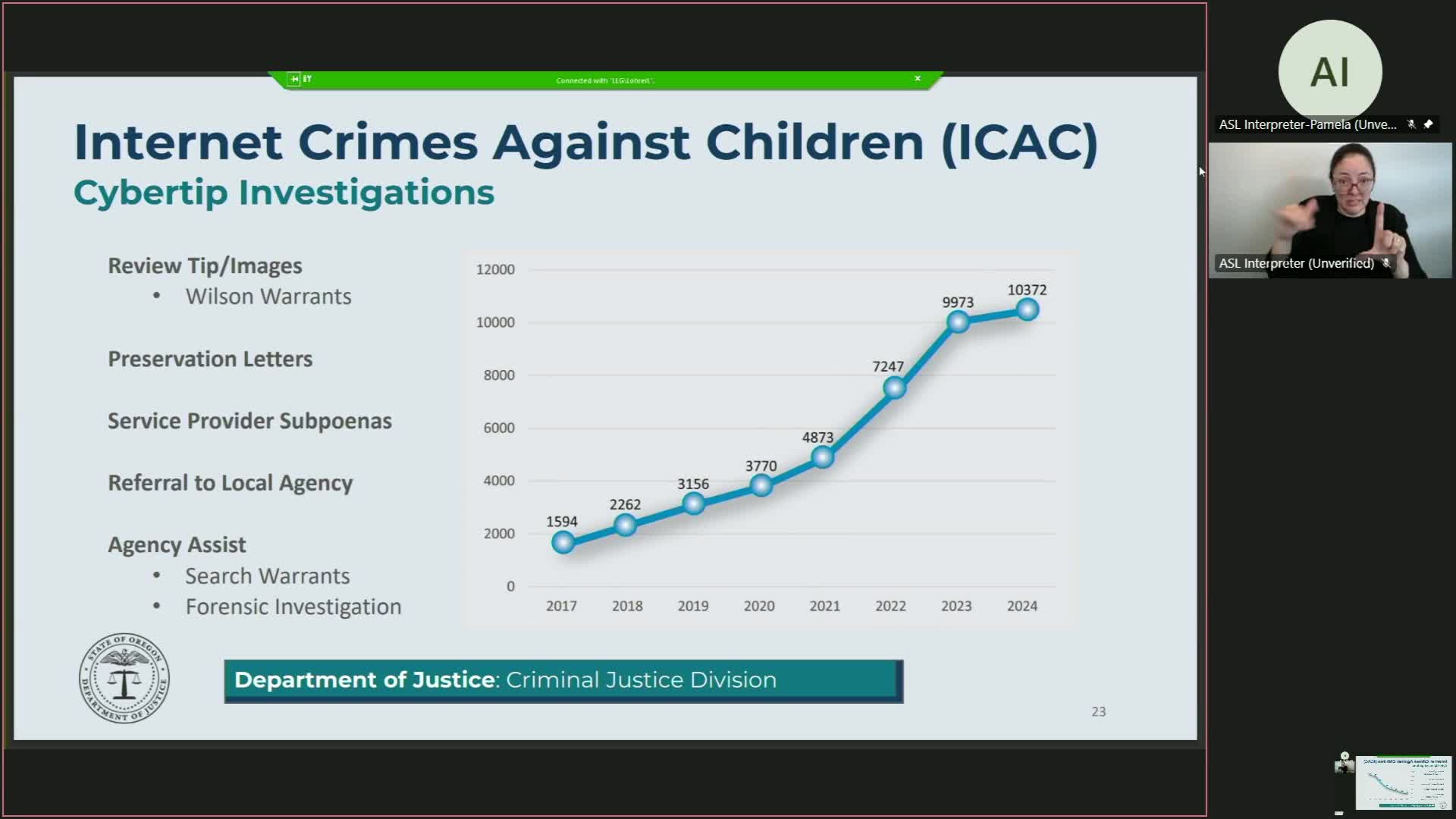Oregon's Organized Crime Unit reports success in tackling retail theft and child exploitation
April 14, 2025 | Public Safety, Ways and Means, Joint, Committees, Legislative, Oregon
This article was created by AI summarizing key points discussed. AI makes mistakes, so for full details and context, please refer to the video of the full meeting. Please report any errors so we can fix them. Report an error »

In a pivotal meeting of the Oregon State Legislature's Joint Committee on Ways and Means Subcommittee on Public Safety, officials gathered to discuss significant advancements and challenges in the realm of public safety, particularly focusing on organized crime and child exploitation. The atmosphere was charged with urgency as representatives outlined the pressing issues facing law enforcement and the innovative strategies being employed to combat them.
One of the standout discussions revolved around the National Center for Missing and Exploited Children, which has recently improved its filtering software. This enhancement has led to a decrease in the number of referrals regarding visual exploitation of children, yet paradoxically, there has been a notable rise in cases involving adults soliciting minors for sexual acts. This shift underscores the evolving landscape of child exploitation, necessitating a more robust response from law enforcement.
The meeting also highlighted the complexities of tackling organized crime, which often appears disorganized on the surface. Officials emphasized the need for collaboration among various law enforcement agencies to effectively dismantle these networks. The challenges are compounded by limited resources, making it essential for agencies to work together to identify connections between seemingly isolated incidents.
A significant focus was placed on the establishment of organized retail crime units, funded by the legislature in 2023. These units have already made substantial strides, responding to numerous requests across multiple counties and recovering significant amounts of stolen property. This proactive approach aims to address the rising threat of organized retail crime, which has become a pressing concern for communities statewide.
The meeting also touched on the critical role of data analysis in enhancing law enforcement efficiency. Analysts within the Criminal Justice Division serve as vital support, helping to connect dots in complex cases and providing strategic insights that can lead to successful prosecutions. Their work is particularly crucial in a state where the number of police officers per capita is low, necessitating innovative solutions to maximize resources.
As the session drew to a close, discussions turned to the future, with proposals for creating regional organized crime response teams. These teams would consist of prosecutors, special agents, and analysts, designed to operate similarly to federal strike forces. This initiative aims to foster collaboration and intelligence-driven investigations tailored to the unique challenges faced by different regions in Oregon.
The meeting encapsulated a moment of reflection and forward-thinking, as officials recognized both the progress made and the hurdles that lie ahead in ensuring public safety. With a commitment to collaboration and innovation, Oregon's law enforcement agencies are poised to tackle the evolving threats of organized crime and child exploitation head-on.
One of the standout discussions revolved around the National Center for Missing and Exploited Children, which has recently improved its filtering software. This enhancement has led to a decrease in the number of referrals regarding visual exploitation of children, yet paradoxically, there has been a notable rise in cases involving adults soliciting minors for sexual acts. This shift underscores the evolving landscape of child exploitation, necessitating a more robust response from law enforcement.
The meeting also highlighted the complexities of tackling organized crime, which often appears disorganized on the surface. Officials emphasized the need for collaboration among various law enforcement agencies to effectively dismantle these networks. The challenges are compounded by limited resources, making it essential for agencies to work together to identify connections between seemingly isolated incidents.
A significant focus was placed on the establishment of organized retail crime units, funded by the legislature in 2023. These units have already made substantial strides, responding to numerous requests across multiple counties and recovering significant amounts of stolen property. This proactive approach aims to address the rising threat of organized retail crime, which has become a pressing concern for communities statewide.
The meeting also touched on the critical role of data analysis in enhancing law enforcement efficiency. Analysts within the Criminal Justice Division serve as vital support, helping to connect dots in complex cases and providing strategic insights that can lead to successful prosecutions. Their work is particularly crucial in a state where the number of police officers per capita is low, necessitating innovative solutions to maximize resources.
As the session drew to a close, discussions turned to the future, with proposals for creating regional organized crime response teams. These teams would consist of prosecutors, special agents, and analysts, designed to operate similarly to federal strike forces. This initiative aims to foster collaboration and intelligence-driven investigations tailored to the unique challenges faced by different regions in Oregon.
The meeting encapsulated a moment of reflection and forward-thinking, as officials recognized both the progress made and the hurdles that lie ahead in ensuring public safety. With a commitment to collaboration and innovation, Oregon's law enforcement agencies are poised to tackle the evolving threats of organized crime and child exploitation head-on.
View full meeting
This article is based on a recent meeting—watch the full video and explore the complete transcript for deeper insights into the discussion.
View full meeting
